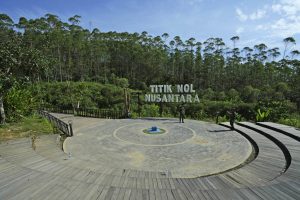Indonesia’s planned new capital city Nusantara has been in the news lately after a flurry of reports that the government is still struggling to attract investors, and as a result is offering very generous financial incentives to increase interest. Deep-pocketed backers who were considering investing in the project, such as Japan’s SoftBank, have reportedly gotten cold feet, concerned about the lack of a concrete vision for the new city.
Nevertheless, President Joko “Jokowi” Widodo is pushing ahead. Even as his second term winds down, he still has the political capital to move the project forward and preliminary construction is already underway. Nusantara will apparently be the home of a new training center for Indonesia’s national football team, and we continue to see flashy concept art providing glimpses of the smart, green city that it will one day be. But how realistic is this vision, and why hasn’t it resonated with investors?
Singapore is often held up as an example of a thriving smart city. And it is indeed very convenient taking a bus in Singapore and getting live updates about routes and wait times on your phone. But people don’t want to live in Singapore because it’s a smart city. They want to live there because it’s safe and clean, has great public transport and infrastructure, excellent universities, and sits at an ancient crossroads of trade and commerce that make it a natural hub for transportation, business, and finance.
Cities designed and built simply to showcase technologies or infrastructure tend to have poor track records. They often sit abandoned or under-used because even though the planning reflects high-minded concepts and the structures are sleek and futuristic, there is no compelling reason for people to live there. China’s empty green cities are a case in point, as is Abu Dhabi’s Masdar City. Despite efficient layouts and modern buildings, there is little there to pull people in.
Even though Jakarta is sinking, polluted, and congested, it is still a city that millions of people want to live in. It has been a major political and economic nexus of the archipelago for centuries and has deep historical roots. It is an immensely complex place that despite its problems creates jobs and opportunities and experiences not easily replicated elsewhere. While I sympathize with the desire to separate the nation’s capital from Jakarta’s colonial history, and to start fresh with a city built by Indonesians for Indonesians, there is a very important question that any such project needs to reckon with: why will people want to live here?
The Nusantara project reflects a larger tension in Indonesia’s development trajectory. In my opinion, Jokowi has very successfully overcome significant hurdles and the quality of infrastructure has improved considerably during his administration. When I first came to Indonesia, there was no Trans-Java Toll Road and no MRT in Jakarta. On the 45-minute drive from Magelang to Yogyakarta, three new hospital buildings went up in just two years. There’s been no shortage of construction, and while we can debate the finer points of financing and building quality and land use, I think on balance it’s been a net positive.
But in a way, despite the challenges, building things is the easy part. The hard part is filling new hospitals with qualified doctors who can provide good healthcare at affordable prices, or reforming urban planning and zoning regulations so that high-density and affordable housing is optimized around Jakarta’s new public transit systems. This is a tension that underlies all infrastructure and investment-led growth because building things contributes to GDP through the formation of fixed capital. But it cannot and should not be divorced from the wider question of how the things we build serve the interests of society at large.
This is also the puzzle at the heart of the Nusantara project. If it wants to be successful, Nusantara needs to be something more than just a green, high-concept smart city with nice roads and landscaping and infrastructure. It needs to have something – or many somethings – beyond physical structures that will draw people in and make them want to live there. This could be a world-class university or cutting-edge research and development centers or a green industrial hub. Potentially, it could be many things. But the ability of Nusantara to outlast Jokowi and be a genuine legacy project will very likely hinge on whether anyone has a good answer to this question.

































